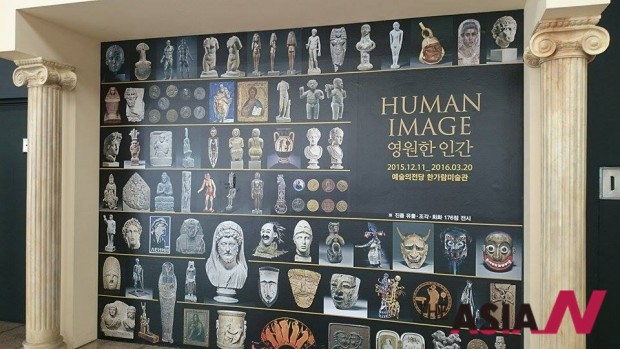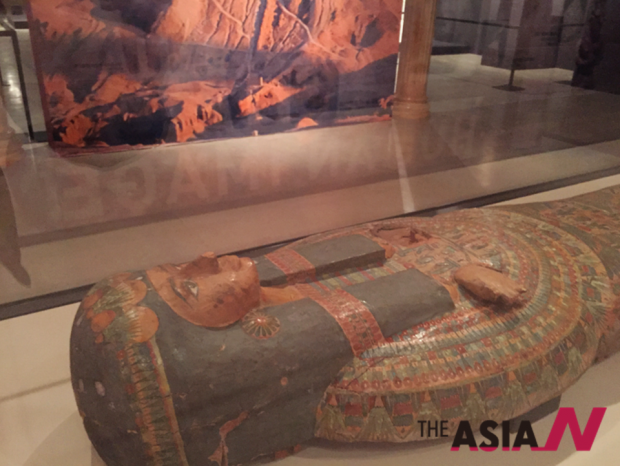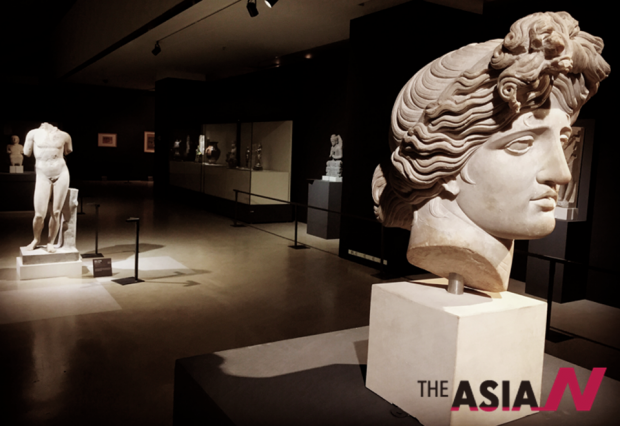‘대영박물관-영원한 인간 展’ 시대 관통하는 예술의 단골소재 ‘인간’
* ‘아시아엔’ 연수 외국기자가 작성한 기사의 한글요약본과 원문을 함께 게재합니다.
[아시아엔=라드와 아시라프 기자·번역 김아람 기자] 예술의 전당에서 오는 3월20일까지 ‘대영박물관-영원한 인간 展’(이하 ‘대영박물관 전’)이 열린다. 이 전시는 세계 3대 박물관 중 하나인 영국 대영박물관에도 전시되지 않은 미공개 컬렉션 다수를 포함해 기원전 8400년부터 2012년에 이르기까지 방대하고 긴 인류의 역사를 직접 눈으로 볼 수 있는 특별한 전시회다. ‘인간’을 주제로 3년간의 기획과 준비과정을 거쳐 한국 최초로 선보이는 이번 전시는 아름다움, 인간, 신, 권력, 변신, 사랑 6개로 주제로 회화작품, 유물, 조각 등 170여점이 넘는 작품들이 대중에 공개된다.
기자는 직접 전시를 방문해 조나단 킹 큐레이터의 설명과 함께 작품을 감상했다. 그는 대영박물관 전에 대해 “그간의 역사와 대륙을 뛰어넘어 인류의 방대한 지식을 총망라한 전시”라며 “인간의 과거, 현재 그리고 미래의 각기 다른 모습을 반영하고 있는 작품들”이라고 설명했다. 본격적인 주제별 작품 감상에 앞서 눈길을 사로 잡았던 것은 기원전 8세기 이스라엘 예리코에서 발견된 사람의 실제 두개골이었다. 특이하게도 눈에 조개 껍질이 씌워져 있었는데, 조상 숭배 의식을 위해 사용했던 것으로 추정된다고 한다.
시대와 지역에 따라 변화하는 이상적인 미의 기준을 한눈에 살펴볼 수 있는 ‘아름다움’ 전시관 역시 인상 깊었다. 인류 역사를 통틀어 ‘인간의 모습’은 전세계 모든 예술가들의 단골 소재로 빠지지 않는 영감의 원천이었는데, 서로 다른 배경을 지닌 작가들이 인체를 완벽하고 이상적인 형태로 묘사하기 위해 시도했던 다양한 방식이 눈여겨볼만했다. 그 중에서도 그리스 신화의 목축과 정력의 신 ‘판’의 대리석상은 단연 인기였다.
‘신’ 전시관은 모든 종교가 ‘인간의 모습을 한 신’을 재현해냈다는 점에 주목하고 중국의 ‘관음보살 좌상’, 이집트의 ‘하토르 여신의 부족’ 등 종교와 문화에 따라 예술 속 신의 모습 변천사를 담아낸 작품들이 전시돼 있었다. ‘권력’ 전시관에서는 로마의 16대 황제였던 ‘마르쿠스 아우렐리우스의 대리석 조각상’부터 이집트의 ‘부서진 파라오의 초상’, 이탈리아의 ‘하드리아누스 황제의 주화’ 등 자신의 우상화를 통해 대중에게 권력을 인정받고자 했던 통치자들의 역사, 그리고 그들이 당시 예술에 끼친 영향에 대해 설명했다.
‘인간’은 우리 모습 그 자체였기 때문에 시대와 종교, 문화적 배경을 막론하고 언제나 늘 다양한 형태의 예술작품으로 묘사됐다. 이번 대영박물관 전은 다양한 관점에서 인류의 예술을 전반적으로 되돌아보고픈 이들에게 좋은 기회가 될 것이다.
The Morphing Human Image
Since ancient times, humans have created images of their distorted bodies. The human figure has been an essential theme in visual arts throughout the history. It is the primordial image, created in a boundless variety of formats and used to express fundamental ideas concerning the human condition. The human image is considered the most changing idea of human civilization, and likewise the human body has been depicted in a variety of art forms from different centuries, regions and cultures.
An Alaskan wooden figure with fox’s teeth, a Mayan maize god with a beautiful head, a real human skull from Jericho, the oldest piece in the museum, from the 8th millennium BC, a skull somehow re-animated with plaster, giving the form of flesh, with shells for eyes, a Gustave Courbet self-portrait – the young artist smug and sly and self-regarding, a tiny Egyptian ivory figure of a girl, with lapis lazuli eyes, her hands folded across her belly and breasts, are just some of what the British Museum’s first exhibition in South Korea has to offer. They deliver over 170 artworks, which include sculptures, paintings, and unrevealed relics on the different representations of the human image through history.
These artifacts representing god, beauty, individuals, authority and politics, metamorphosis, and love are the result of three years of extensive and elaborate preparation for this specific exhibition. The pieces include sculptures of Greek and Roman era, an Egyptian mummy coffin and artifacts that include statues of Isis and Amun-Ra, drawings and engravings by Rafaello, Picasso, Rembrandt, and Matisse among others, covering a wide range of ages from BC 8400 to 2012.
Combining visual spectacle with profound insights, the human image explores the varying ways that artists of different cultural traditions have represented the human body and imbued it with meaning.
But what sets this exhibition apart is how you navigate its sections through different perspectives, from observing god depiction in art to witnessing the morphing image of the human body. The different sections resemble a jigsaw puzzle, as you start putting the pieces together after taking in each part.
The British Museum had a run of successful exhibitions, as in 2015 alone, they held five magnificent exhibits; from defining beauty of the Greeks and analyzing the identity and art of Celts to discovering the change of faith in Egypt after the pharaohs and the enduring indigenous civilizations of Australia.
A trip through history:
The museum which is curated by Jonathan King, acts as a history class on a larger scale. According to him, “The exhibit showcases artworks that encompass our collective human knowledge. They reflect human nature in its past, present and future form.”
The first section “Ideal Beauty” shows works by artists with different backgrounds and traditions expressing human body in various ways. “Marble Statue of Pan” (45-25 BC) was among the most anticipated pieces in that section. The Marble male nude Statue of Pan, signed by M. Cossutius Cerdo, was discovered at a villa at Monte Cagnolo, near Rome, Italy. In Greek religion and mythology, Pan is the god who symbolizes fertility and male sexuality. “Marble Statue of Pan” used the sleek marble surface to show immortal and masculine beauty.
The second section ‘Expressing the person’ shows different types of portraits, and how they don’t merely reflect personalities, they reflect souls as well. One of the most haunting pieces of that section was the portrait of a woman found in Saqqara, Egypt. The third section ‘The Body Divine’ offers an opportunity to navigate through various human manifestations of god in different cultures and religions, from Buddhism to Christianity.
The fourth section revolving all around politics presented rulers of history, such as the likes of the Roman emperor Marcus Aurelius. “Marble Head of Marcus Aurelius” offers a portrait bust of the emperor made using the heavily textured details of marble for his adorned hair and veil to express the authority and prestige of the emperor. While the last two sections showcased the transforming and changing nature of the human body and the ‘human image’ as well as relationships and their role in forming our identities through African demon masks and paintings lush with illustrations.
The exhibition approaches the subject of the human figure in a fresh, accessible and exciting way: iconic works from ancient civilizations are juxtaposed with striking modern artworks; imposing large-scale paintings and sculptures are set against more intimate personal images; diverse artistic practices and cultural traditions are compared and contrasted.
Deities, jokes, ritual objects, symbols, we can only surmise their original meanings, the intentions of the hands that made them. All we know is that the human image endures, even in the museum, and that a thing no bigger than your fist can be as resonant and compelling as an entire galaxy. Such items can’t escape being categorized and historicized, as we cannot resist the temptation of digging too deep to know the story behind a certain object.








